In July 2013 I was meandering around southern Manhattan, if only to take some fleeting solace in the madding crowd, and while in St. Paul’s Churchyard, I saw an unusual tall building on Vesey Street at #20 that I immediately realized required some research. At the ground floor, people were lined up at the headquarters of the 9/11 Memorial Visitors Preview Site. Pillory me if you wish, but I’ve alway been opposed to the construction of an elaborate 9/11 memorial, because it’d always be turned into a tourist attraction and continue to encourage the presence of hawkers selling photos, souvenirs and gewgaws depicting the events of that most horrible day in US history in my lifetime. That’s neither here nor there, as the memorial site is under construction, but I don’t plan on visiting.

At the ground floor, there’s an ancient tobacconist shop, and an old clock that’s been out of working order for some time.
The 13-story building features four now-verdigris’ed monklike figures on the façade just below the roofline…
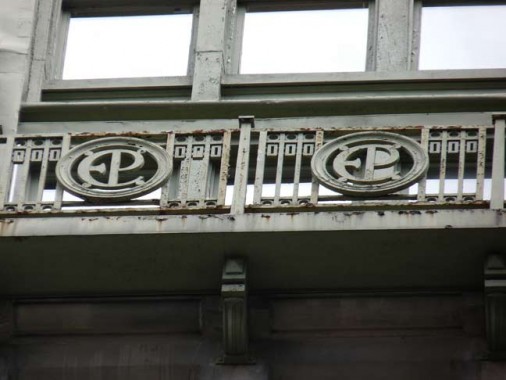
… and some railings emblazoned with the letters EP between the figures. What’s going on here? I had to find out.
It turns out this is the former headquarters of the New York Post, when it came out in late afternoons and was called The New York Evening Post (explaining the EP’s). The Post was still adhering to this schedule when I was a kid, and was coming out during the PM hours, and would sometimes publish partial baseball line scores if there was an afternoon game (this was before the days of espn.com, when you didn’t have the score at your fingertips at all times).
The building was commissioned by Post owner Oswald Garrison Villard (grandson of abolitionist William Lloyd Garrison) and is officially called the Garrison Building, not for the owner’s middle name, but because the broker was Garrison Realty. Architect Robert D. Kohn had the building finished in spring 1907 in the Art Nouveau style, rare in NYC but more popular in Paris. It is steel-framed and covered with limestone with what appears to be copper sheathing from the green verdigris.
The four monks, by the accounts I’ve seen, were meant to represent the “Four Periods of Publicity”; two were sculpted by Kohn’s wife, Estelle Rumbold Kohn, and the other two by Gutzon Borglum, the sculptor of the massive Presidential figures on Mt. Rushmore, South Dakota.
The building housed the Post’s printing presses and later, other publications like The Nation and The Crisis were printed here, and Yachting Publishing, Ronald Press, and the U.S. Nautical Gazette. Other firms included the manufacturer of school blackboards. By the 1940s, when the Post had moved out, the building was owned by Mutual Life Insurance.
Five stories of bay windows comprise the building’s middle section. Each set of windows is, in turn, punctuated by crests, each holding a symbol. The same symbol appears on each floor three times, totalling three sets of five symbols. So, what do the symbols represent? I’m not sure about all of them, but I’m sure of the theme.
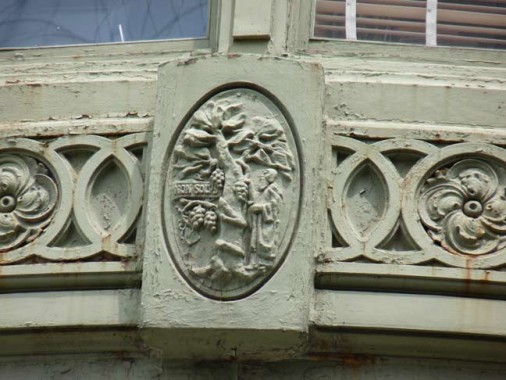
The first depicts an old man standing under an elm tree entwined by grapevines, with a banner saying the Latin phrase “non solus” or “not alone.” This is the printer’s mark of the Dutch publishing firm Elzevir, which was founded in 1580, give or take a few years, by Louis Elzevir. His son Isaac introduced the mark in 1620, which subsequently appeared on all publications by the firm. The symbol is said to represent the mutually beneficial relationship between the publisher and the scholar. The modern firm Elsevier is not a descendant of the ancient publisher, but does use the mark.
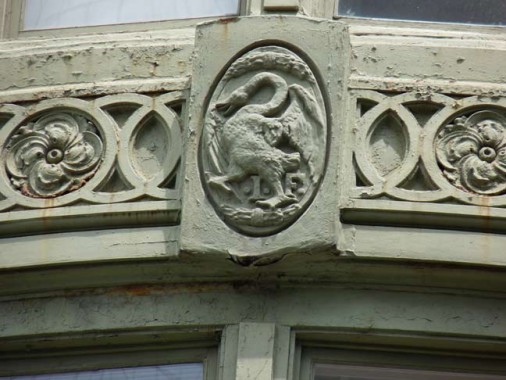
Above the next set of windows is a symbol depicting a long-necked bird — a crane, goose or swan, with the initials I.F. I do not know what this symbol represents.
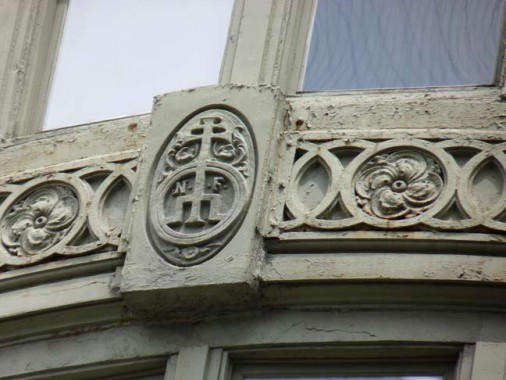
The third symbol is a stylized trident in a circle, with the initials N.F. Again, you got me here. Anyone know this one?
From Comments:
The third symbol belongs to Nicholas de Francfordia of Venice (15th century). It was common at the time for printers to have a variation of a cross with their initials for their mark and his was one of the more distinct. See page 25 of this document: http://www.gutenberg.org/files/25663/25663-h/25663-h.htm
Here’s some general information about the uses of the swan, olive branch, and serpents – but nothing on those specific marks or printers (paragraph about 2/3 down): http://www.library.illinois.edu/rex/about/windows/article.html
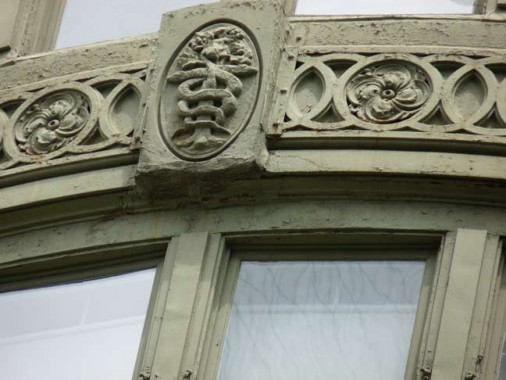
The fourth symbol shows two snakes entwined around a tree. It’ similar to the caduceus, the symbol of Roman messenger god Mercury, though not quite the same.
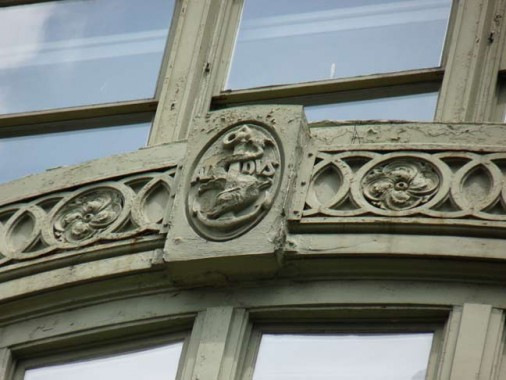
 The fifth symbol was fairly easy to decipher even if the word “Aldus” wasn’t there.
The fifth symbol was fairly easy to decipher even if the word “Aldus” wasn’t there.
Italian pressman Aldus Manutius (1449-1515) who established one of Italy’s finest printing presses in Venice in 1493. It is thought he invented the slanted style we call italic type.
Aldus is the name of a former software company that made, you may recall, an early giant in the desktop printing biz, Aldus Pagemaker. It was purchased by Adobe, which updated it through 2001; Adobe has pretty much succeeded it with the more complex InDesign.
Flocks of NYC streets are named for the signers of the Declaration of Independence, NYC mayors, Trinity Church vestrymen, classical composers, even astronauts. But printers? Why not?
Aldus Street in Longwood, Bronx runs through the former estate of Colonel Robert Hoe, inventor of the rotary press. When the city developed the area and streets were cut through, three were named Hoe Avenue (which is still there) Guttenberg Street (now East 165th), and Aldus Street.
So, I think we can deduce that all five symbols have been printer’s marks, in a building housing printing presses for a great city newspaper. Can anyone tell me what the middle three are?
Comment below or tweet to Kevin Walsh @ForgottenNY
9/19/13

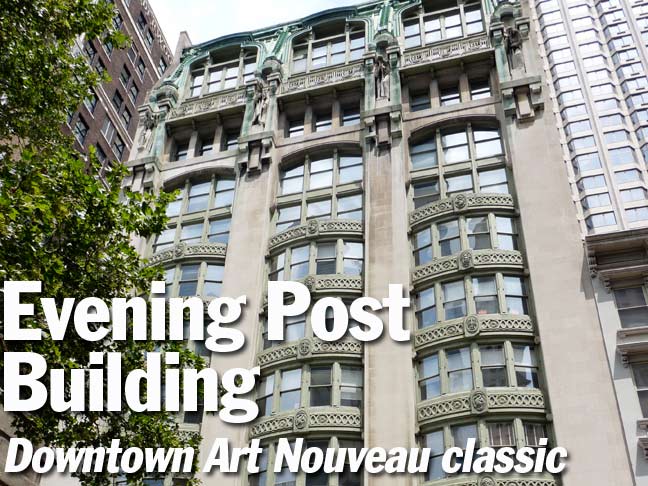
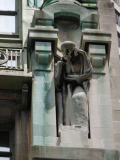

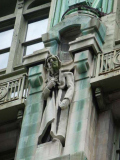
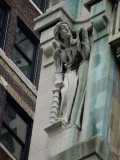
17 comments
The third symbol belongs to Nicholas de Francfordia of Venice (15th century). It was common at the time for printers to have a variation of a cross with their initials for their mark and his was one of the more distinct. See page 25 of this document: http://www.gutenberg.org/files/25663/25663-h/25663-h.htm
Here’s some general information about the uses of the swan, olive branch, and serpents – but nothing on those specific marks or printers (paragraph about 2/3 down): http://www.library.illinois.edu/rex/about/windows/article.html
If memory serves me correctly, 20 Vesey St also features a pent house with a rooftop garden. I worked at 2 World Trade Ctr (83rd floor), 1974-80. I was able to look down at this great piece of architecture daily. To this day I have no idea who has/had the priviledge of calling this great place home.
Actually, Adobe updated Pagemaker with InDesign. Dreamweaver is more of a web production tool–their old HTML editor was Adobe Page Mill, which, legend has it, was named after Page Mill Road, a street in Mountain View, California, in Silicon Valley.
Got it
Kevin, I can’t enlighten you on the printers marks but I can thank you for a fascinating post. Very interesting stuff. At one point most of the major New York newspapers were all located within a few blocks of one another.
The four periods of publicity? Maybe I missed class that day, but anyone know what the four periods are?
I don’t think even the sculptor knew. I think they just wanted some good allegoric-themed sculptures.
I have a feeling that whatever they were, the fourth (and most momentous) period was the Evening Post.
My 6th great grandmother Elizabeth Weaver Greenwood Cozort called 20 Vesey Street home in 1831; although she didn’t live in the Garrison Building. I would love to know what stood at this address prior to the Garrison.
Thank you for researching and posting this. Living at 10 Barclay St. I see this hidden gem weekly. It’s a special building unnoticed amongst the giants of NYC, unfortunately falling into disrepair. Hopefully a developers flips the property and it’s uniquenes shines as it did in the past.
I appreciate this article. My second great uncle, Emil Maurice Scholz, worked for the New York Evening Post from here in 1913 – 1919 as the Business Manager, Secretary, Publisher, Director. Afterwards, he left to start the World Wide Advertising Company. D. Berchtold at dabfamilytree@gmail.com
The Third Sub-Basement at 20 Vesey St.
I worked at a law firm, Pazer & Epstein, later, Pazer, Epstein & Jaffe, at 20 Vesey with my father, Perry Pazer. The firm and several sub-tenants occupied the 7th Floor beginning about 1987. It was a remarkable building. The bay windows looking out over St. Paul’s Chapel, and the church yard trees and it’s cemetery, provided an ever changing and very beautiful view from my father’s desk. These windows also provided a front row seat for the events of 9/11, the long work on the pile, and the recreation of the site…. For us, thankfully no one was injured in the events of that day, though a number of folks in the office chose not to return, or did not return for long. We were ousted from the building from Sept. 2001 through much of November, while the building was inspected, repaired, and cleaned, and the neighborhood made safe for visitors and workers to return.
But I must comment on an experience I had at 20 Vesey Street in a part of the building that is hidden from view. Our office stored our unused files in the second sub-basement of the building. This was a dark, and forbidding realm which could only be reached by a service elevator located in the 1st sub-basement. With only an occasional bare low-wattage bulb here and there, this always felt to me to be the place where nightmares were made. The paint was peeling, there piles of plaster that had fallen off of the ceiling ages ago and never been picked up, there were random objects of unknown age, covered by an inch of dust, strewn everywhere in unlit and unused side rooms with doors hanging, uncertainly, and at odd angles, from their hinges. The second sub-basement was however, not the bottom! I note for the record that these were not normal height basement ceilings, these were twelve feet tall or higher, which gave the whole place the feel of a cavernous ancient catacomb. One day after I had asked our Super for a hand moving something in our storage area, he asked me if I had ever been down to the third sub-basement? Flashlight in hand, he led me on a dark guided tour, the length of the basement with its empty echoing rooms, and down a long and unlit staircase into the third sub-basement of the building. Here things were in even worse shape than above. There was something here that he said he really wanted to show me. We came to a stop in front of a very large and ancient metal clad insulated sliding door about ten feet wide and as tall as the ceiling, hung on a rail. At first I thought he would never be able to slide it open, but as we drew closer I could see that it wasn’t completely closed. It was open just enough room to slip into the room. I followed him in, turning sideways, and carefully sidling in, trying to keep my suit and tie from getting any dirtier than fussing with the old files had already made them.
Beyond the giant door was a massive two-story-high coal fired boiler that was once used to create the steam to heat the building. It was about the size of a New York Post delivery van standing on its tail, a round riveted pressure vessel with massive pipes going in and out, port holes to see the fire, doors to shovel in the coal, giant valves to regulate the flow of steam and water. It was like discovering that your building was heated by godzilla breathing fire on a kettle to make steam!
One can only imagine what that room must have been like when that behemoth was roaring hot and pumping steam through the building’s uninsulated rooms with single pane glass windows in the dead of and old-fashioned frigid New York winter at a time before global warming, while the New York Post’s pressmen chased a hickey across the plates of the “Extra” edition in 1907. The Super smiled at me as I gawked, and stood speechless in the third sub-basement of 20 Vesey Street, behind the giant fire door across the street from the old World Trade Center.
“Hey, very strange to see, right?” I didn’t really hear him. I’m not sure how long I stood looking.
Hey man, you can stay here if you want to, but I gotta go….” Luis jibed at me, breaking into my revery.
“You’ve got the flashlight, Luis; I’m com’in with you! Please take me back to the surface.”
Jonathan Pazer
Amazing – thanks for sharing that story, Jonathan!!
In medieval Europe, the pelican was thought to be particularly attentive to her young, to the point of providing them with blood by wounding her own breast when no other food was available.
In 1937, 20 Vesey Street was the address of the Medical Bureau of Friends of Spanish Democracy,
I am part of the editorial team preparing The Letters of Ernest Hemingway for publication, and we have the texts of two cables that Hemingway sent to the Medical Bureau, about donations for buying ambulances to send to Spain during the Spanish Civil War. Any information anyone could provide about the Medical Bureau housed in this building would be most welcome. I am especially interested in its archive, if any such exists. The Medical Bureau seems to have been associated with the Lincoln Battalion of the International Brigades.